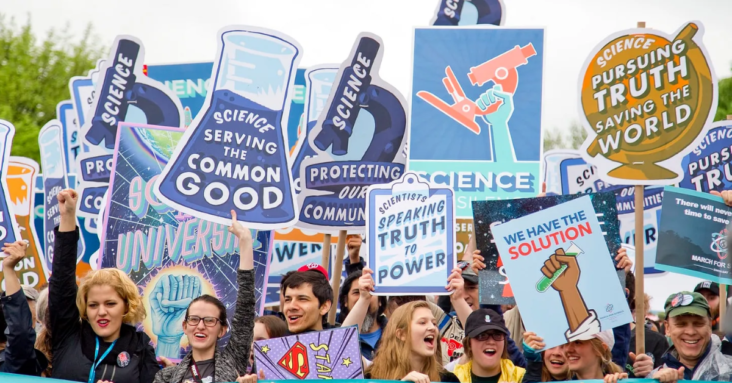
“Scientific consensus” surrounds us everywhere. We saw it with all things COVID despite the fact that, to me at least, it seemed that doctors, scientists, and other experts in the field who were questioning government health policies during this time, like lockdowns, vaccine mandates, vaccine safety/efficacy and mask mandates were actually in the majority. Or at least a very large minority.
We were presented with a “clear consensus” type of narrative via mainstream media and government health authorities, but this clearly wasn’t the case.
In a recent interview, astrophysicist Neil deGrasse Tyson was asked about his scientific views about COVID-19 and he said “I’m only interested in consensus.” So, agreeing with the “consensus” is quite prevalent today even though it may not even be the consensus.
I’ve said it before many times and I’ll say it again, the mainstream can make the majority seem like the minority and the minority seem like the majority.
“I regard consensus science as an extremely pernicious development that ought to be stopped cold in its tracks. Historically, the claim of consensus has been the first refuge of scoundrels; it is a way to avoid debate by claiming that the matter is already settled…Consensus is the business of politics….The greatest scientists in history are great precisely because they broke with the consensus. There is no such thing as consensus science. If it’s consensus, it isn’t science. If it’s science, it isn’t consensus. Period.
– Michael Crichton – physician, producer, and writer
We’ve also seen consensus propaganda in other areas like climate science. The public is often told that approximately 97 percent of scientists agree with the catastrophe narrative, but this isn’t true when we really explore where this claim came from.
As Aaron Kheriaty, a fellow at the Ethics and Public Policy Center, recently said:
“Science is an ongoing search for truth & such truth has little to do with consensus. Every major scientific advance involves challenges to a consensus. Those who defend scientific consensus rather than specific experimental findings are not defending science but partisanship.”
It reminds me of “Groupthink.” It’s a phenomenon that occurs when a group of individuals reaches a consensus without critical reasoning or evaluation. It’s based on a common desire not to upset the balance of a group of people, or the “herd.”
It Was So Obvious That Mass Censorship Was Needed
What we were being presented with regarding all things COVID was opposed by so many experts in the field that a massive censorship machine had to step in and uphold the status quo of “consensus.”
New emails released during litigation against the Biden administration reveal incredible efforts to silence the concerns of many scientists, doctors, journalists, and other experts in the field. They actively censored content they knew contained, as White House officials Andy Slavitt and Rob Flaherty called it, “true content” to protect political policy.
Throughout the pandemic fact-checkers have not really been fact-checking, but rather narrative checking. Social media has been one of the many long arms of the government to enforce its narrative control tactics.
The origin of COVID is a classic example. Twenty-seven scientists published a letter in The Lancet condemning “conspiracy theories” that suggested the virus did not have a natural origin. Dissenting views were censored on social media and labelled “misinformation.” But now, the US Department of Energy and the FBI say the virus was likely the result of a lab leak in Wuhan. Even though their confidence level in the evidence is low, it still remains a strong possibility that wasn’t allowed to be openly discussed before. Why?
The recent release of the ‘Twitter Files’ revealed how government agencies, Big Tech, media, and academia colluded in an effort to police online content, and censor dissenting voices to create a false perception of consensus.
I go more in-depth on this massive censorship machine and the relationship between Big tech, media and several federal agencies that have orchestrated it in the article below for those who are interested.
Shame and Ridicule Ensues
The shaming started right from the start of the pandemic. On Twitter, #covidiot started to trend on the evening of March 22, 2020, and by the time the night was over thousands of tweets had co-opted the hashtag to denounce poor public health practices.
Words like selfish dumbfucks, village idiots, flat earther, inbred trash, negative IQ, and more became quite common. It was sad to see. People encouraged hospitals to not provide care for anybody who opposed what we were being told by the government.
That is how quickly the masses can be made to believe something, especially when massive amounts of fear and propaganda are used to paint a misleading picture that’s far from the truth.
It’s discouraging to see how quickly we can turn on our fellow citizens.
A piece written by Gabrielle Bauer, titled “Those Who Chose Shaming Over Science” explains,
“From the earliest days of the pandemic, something deep inside me – in my soul, if you will – recoiled from the political and public response to the virus. Nothing about it felt right or strong or true. This was not just an epidemiological crisis, but a societal one, so why were we listening exclusively to some select epidemiologists? Where were the mental health experts? The child development specialists? The historians? The economists? And why were our political leaders encouraging fear rather than calm?
The questions that troubled me the most had less to do with epidemiology than with ethics: Was it fair to require the greatest sacrifice from the youngest members of society, who stood to suffer the most from the restrictions? Should civil liberties simply disappear during a pandemic, or did we need to balance public safety with human rights? Unschooled in the ways of online warriors, I assumed the Internet would allow me to engage in “productive discussions” about these issues. So I hopped online, and the rest was hysteria.”
When I talk about shame and ridicule, I like to point to a paper I’ve cited in many of my articles from several researchers from academic institutions in the United Kingdom, United States and Canada.
“Public and political discourse quickly normalized stigma against people who remain unvaccinated, often woven into the tone and framing of media articles; for example, a popular news outlet compiled a list of “notable anti-vaxxers who have died from COVID-19” (Savulescu and Giubilini, 2021). Political leaders have singled out the unvaccinated, blaming them for: the continuation of the pandemic; stress on hospital capacity; the emergence of new variants; driving transmission to vaccinated individuals; and the necessity of ongoing lockdowns, masks, school closures and other restrictive measures.
Political rhetoric has descended into moralizing, scapegoating, blaming and condescending language using pejorative terms and actively promoting stigma and discrimination as tools to increase vaccination.
This has become socially acceptable among many vaccinated individuals and pro-vaccine groups as well as the public at large. The effect is to further polarize society – physically and psychologically – with limited discussion as to the reasons why people remain unvaccinated.“
So, the next time you hear the words “scientific consensus.” Remember this article



